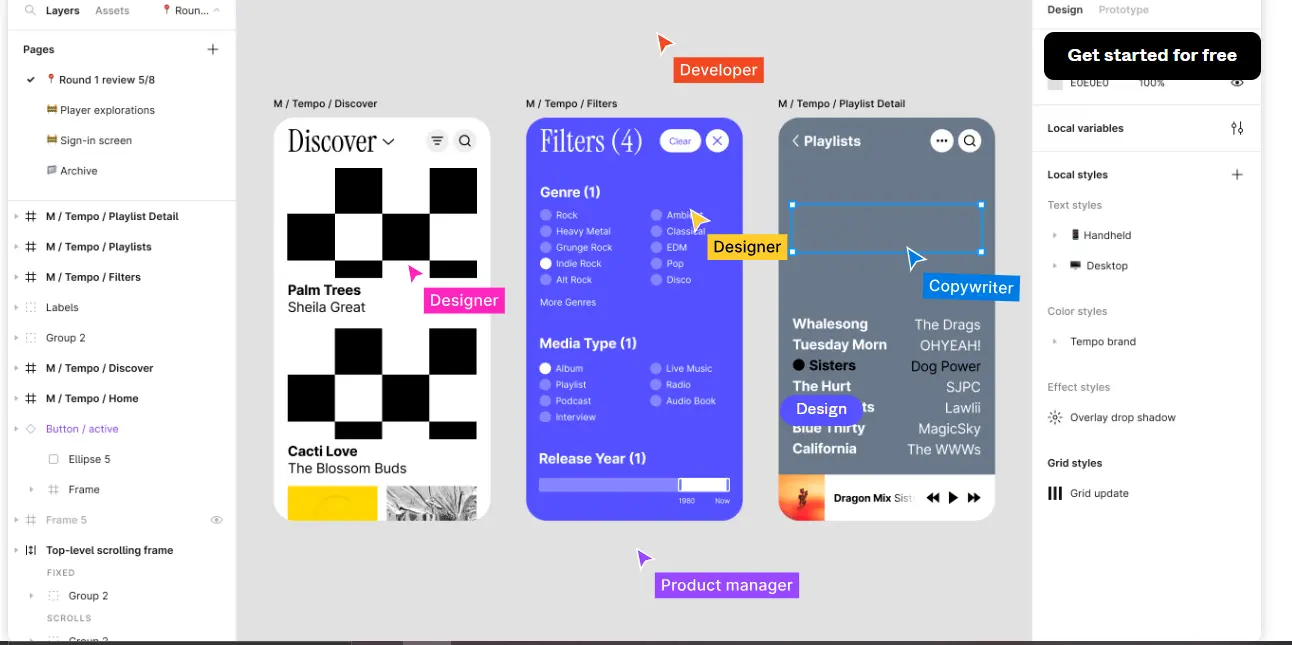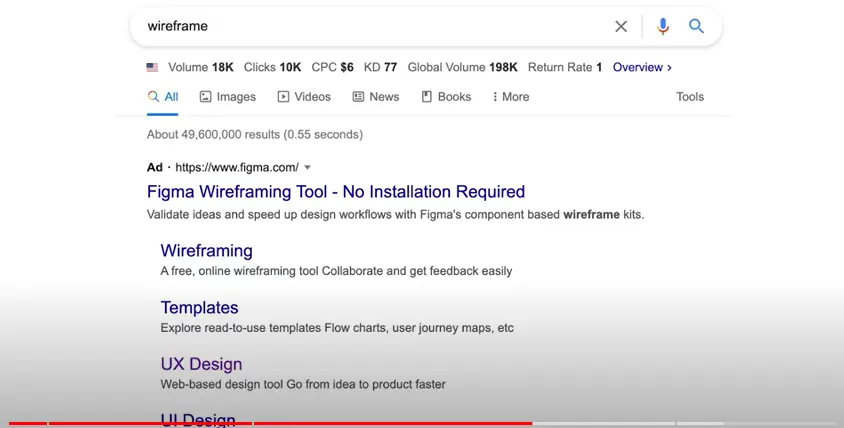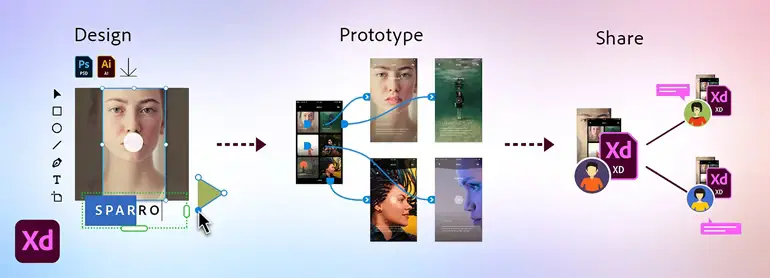
Last September, Adobe made headlines by announcing its acquisition of Figma for $20 billion. But why would Adobe pay 50 times more than Figma’s annual revenue for just a design tool?
The reasons are worth knowing. Let’s take a look at what happened exactly and why this acquisition was beneficial for Figma and how Figma’s marketing outsmarted SEO expert Neil Patel.
Table of contents
- What is Figma?
- How Figma and Adobe Competition Started
- How Did Figma Beat Adobe?
- Inside The Adobe Figma Acquisition
- Figma Could Have Denied The Acquisition
- Why Was The Figma Adobe Deal Got Called Off in 2023?
- In Conclusion
- Frequently Asked Questions
What is Figma?

Dylan Field founded the cloud-based design tool Figma in 2012. While the design tool’s features and functionality are similar to Sketch’s, Figma provides differential features that set it apart from other tools.
It has features like:
- It works on any platform
- Collaboration is easy
- It uses Slack for team communication
- The embedded Figma files provide real-time updates
- Let’s you comment (Great for giving design feedback)
- Its APIs provide third-party tool integration
- Straightforward and intuitive prototyping
As the use of remote and hybrid work increased during the pandemic, Figma gained popularity. By 2022, more than 4 million designers worldwide were using its products.
How Figma and Adobe Competition Started
Adobe, a powerhouse in the world of design and photo/video editing, was established in 1982 and has held the throne since. Despite having competitors like Sketch, Adobe remained unruffled, as these rivals were stuck in their old ways of doing business.
However, things changed with the entry of Figma in 2012, bringing with it distinctive features that quickly made it a favourite among designers. Figma’s user-friendly interface was the icing on the cake, catching Adobe off guard as it had only felt significant competition then.

Faced with innovation and speed, Figma consistently rolled out new features and updates that turned heads. Feeling the heat, Adobe decided to step up its game and launched Adobe XD on March 14, 2016. This widely used tool is an integral part of Adobe’s Creative Cloud suite, specialising in prototyping user interfaces (UI) and user experiences (UX) for various software types, including web and mobile applications.
To strengthen their position, Adobe collaborated with prominent SEO service providers and experts like Neil Patel. This partnership aimed to generate buzz by discussing, writing and creating hype around Adobe XD. For a considerable time, both Adobe and Figma pushed each other to innovate, constantly introducing new features and improvements. However, there came a point where Adobe couldn’t keep up with Figma’s pace, leading them to make a strategic decision – to acquire Figma.
How Did Figma Beat Adobe?
Figma outpaced Adobe with just three words: Content, SEO and hiring. Let’s delve into a recap of Figma’s marketing strategies.
Content – The Golden Rule
The golden rule of content is simple: if you would not read it yourself, chances are no one else will. Enjoying the content you produce is a litmus test for its attention-worthiness. Crafting content that resonates with your audience and sparks engagement is necessary for the growth of marketing functions. Creating content merely for the sake of it, without carefully considering its quality or relevance is like “motion without progress.”
Focus on original and creative content
This is one of the key recommendations for any experienced digital marketing company. Now take a closer look at how Figma tackled content creation. They took an intriguing approach to content creation. Their strategy centred around being original and creative, focusing on whether they, as creators, would genuinely want to read or share the content they were producing. If the answer was no, they scrapped it.
Creating relevant content
Before creating any content for the users, Figma leaders made sure to use their tool themselves and better understand user needs. Toni, Figma’s early growth marketer first used to use the product and understand the existing and potential users. This helped him create creative content. The content assists users in getting skilled with the tool, Figma creates an extensive amount of educational content, including blog entries, courses and tutorials. In addition, it helps with getting users and retention, this content positions Figma as a leader in the design industry.
Make your content Authentic
Many times, businesses try to keep up with the competition by creating and publishing content that may be outside their expertise. However, authenticity is still highly valued, and Figma exemplifies this. Instead of writing the typical ‘how-to’ blogs promising specific results, Figma focused on being genuinely helpful to designers. They uniquely speak to their audience and cover diverse topics, but their authenticity resonates with their audience. This authenticity gave them an edge over companies like HubSpot and Neil Patel, who heavily emphasise ‘how-to’ content.
Here’s a quick lesson: When connecting with technical audiences, especially early adopters, it’s not always about providing ‘how-to’ content. They’re more interested in understanding WHY you built what you built and WHAT they gain from it.
Check out the examples of their content below:


SEO and SEM
Figma crafted an impressive product, and now it was the time to attract those who are open to different brands. Their goal was to catch them at the exact moment they were trying to solve a problem using Figma or when they were considering a purchase.
Look at Figma’s search volume since 2015, most queries were

The genius move in Figma’s search marketing strategy was its focus on wireframing. Recognising that wireframing often kicks off the design process, they have strategically aimed to own this space. They even bid on terms like “wireframe” Indicating a bold approach that may not suit every company.

While this strategy might not be suitable for most businesses, they might need to get professional SEO services. Businesses, especially smaller ones, may find it helpful to consult with an expert SEO company when navigating these strategies. But Figma’s massive budget allowed them to dominate industries and market sections, like wireframing. They understand that if they capture users at the wireframing stage, they are likely to keep them throughout the design process. Their meticulous use of both paid ads and SEO helped them secure top positions for high-intent queries, leading to a well-rounded and effective marketing flywheel. This holistic approach ensured Figma’s growth became a self-sustaining flywheel with evolving network effects.
Hire people who can do ‘stunts on their own’
The person who wants to learn can be taught, but the person who doesn’t want to learn anything cannot be taught, no matter what you try. Figma embraced this idea when hiring. Instead of searching for people ‘skilled’ in a specific job, they sought out and hired individuals who were eager to learn and quick to adapt.
Toni, the early growth marketer for Figma, sought what he called ‘growth athletes’—people capable of navigating various aspects of growth marketing, each with their own specialities. These individuals were ‘speed-obsessed, experimentation-minded and eager to throw a lot of spaghetti at the wall to see what sticks.’
Rather than immediately outsourcing to agencies, Toni and the early growth team ‘did all their own stunts.’ This approach allowed them to develop skills, gain knowledge and cultivate a deep understanding of Figma’s users.
Here’s a quick lesson: Use your product, understand your users, be purposeful in your efforts and create a culture of learning and development.
Inside The Adobe Figma Acquisition
Although Figma had not established itself as a ‘clear competitor’ against design giant Adobe, it was expected to gain a total market share of $16.5 billion by 2025.

As the market became more saturated with new generations of design tools, Adobe’s core business growth was decreasing. Therefore, Adobe has a lot of reasons to think about purchasing the promising Figma. Through this acquisition, Adobe could expand into a market that has not yet yielded results.
What was the Bid
So here was the bid. Adobe purchased Figma for $20 billion (half in cash and half in equity). The CEO and staff of Figma received an additional 6 million restricted stock units, which vest over four years. Co-founder and CEO of Figma, Dylan Field continued to oversee the Figma team but had to report to David Wadhwa, head of Adobe’s Digital marketing division. Both businesses carried on independently up to the anticipated closure in 2023, which was approved by stockholders and regulators.was Adobe’s biggest acquisition to buy an already-existing business. But, why didn’t Figma deny the acquisition? It already had a competitive edge over Adobe. Let’s know why.
Figma Could Have Denied The Acquisition
Figma was intelligent enough to approve of this acquisition. They knew at some point that their creativity would reach a saturation point, and they were getting two things out of this transaction. Of course, money is important, but so are the knowledge and cooperation of large companies like Adobe. While Figma offers full design features, Adobe has been the industry leader in graphic design since 1982.
This was advantageous to them both. merging these two businesses. With Figma’s cloud-based features, designers may keep using the tried-and-true Adobe tooling.
Why Was The Figma Adobe Deal Got Called Off in 2023?
Following the acquisition, the UK’s Competition and Markets Authority (CMA) opened an investigation and “found competition concerns,” which were used to prevent the deal from closing. This was earlier in 2023. After the deal was finalised, the CMA asked Adobe to sell Figma Design, which was the primary product that Adobe had originally intended to buy from Figma. For months, there was back and forth between the two entities, but the CMA remained firm.
The European Commission then released a statement in August announcing its decision to inquire into the merger due to its “concern that the transaction may reduce competition in the global markets for the supply of interactive product design software”. To worsen the situation for Adobe, the Department of Justice also started an inquiry.
Adobe and Figma realised that the game was against them and that it would be preferable for them to back out of this agreement than to battle.
In conclusion
The Adobe-Figma acquisition case study highlights the importance of staying adaptable in a dynamic marketplace. Along with staying adaptable implementing smart content and SEO strategies can get you places, like it did to Figma. Pairing adaptability with savvy content and SEO strategies, as seen with Figma, can truly propel your brand.
Hold on to the potential of design tools and think about teaming up with our digital agency in Ahmedabad to elevate your brand through innovative and impactful design strategies. Reach out to us today at hello@florafountain.com for a personalised design consultation that caters to your unique needs.





























